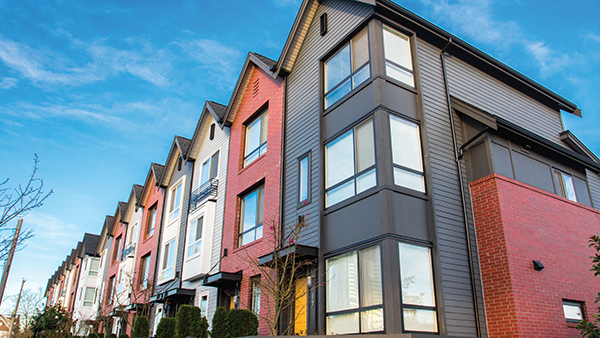As someone who’s been in this industry for years, I’m often asked by investors what is the better investment: single-family or multifamily?
There has been much written on the different aspects of financing, buying, and selling a multifamily property. But what about the day-to-day management and operations of the property?
At Grace Property Management, we have managed both types of properties for over 40 years. And over those four decades, we’ve amassed a trove of insight on the pros and cons of holding and managing the day-to-day operations of a multifamily property as compared to a single-family portfolio.
Here’s our unbiased assessment of single-family versus multifamily in the context of comparing an imaginary 10-plex to 10 single-family homes.
PROS:
Only One Location: This reason is cited most often in buying a multifamily property versus multiple single-family homes. With multifamily, you will only have one property to take care of rather than multiple locations. There’s only one roof, only one parking lot, only one place to have to do repairs. This is true, but keep in mind that under that one roof you have 20 toilets, 10 garbage disposals and 10 sets of appliances.
Lower Price Per Unit: The cost to purchase 10 single-family homes is high when compared to a 10-unit multifamily property. As a buyer, you are able to get more units for your money.
Easier to Increase Property Value: The value of a multifamily property is normally based on the income that the property generates. If you can figure out a way to increase income or decrease expenses, you have just increased the value of the property. Small changes in income and expenses can result in big changes in value.
Some ways to increase value income beyond rent increases are to install coin-operating laundry machines, charge for covered parking, back-bill for utilities. Ways to reduce expenses can be anything from renegotiating trash contracts to installing energy-efficient appliances.
Properties that have not maximized this concept are often referred to as ‘value-added’ opportunities.
This concept contrasts to the value of a single-family home which is much more market driven.
CONS:
Neighbors are Watching: We’ve never seen a marijuana “grow” facility in a multifamily property. Why? Because the neighbors are always watching. Tenants who are loud, cause damage, try to move in multiple other occupants, or are just generally ‘bad’ will be reported by their neighbors living across the hall. It is like having another set of eyes on each tenant.
More Frequent Turnover: Generally speaking, tenants in multifamily properties are more transient in nature. These tenants are often first-time renters and as they grow older and add a spouse or kids, they need the garage for their three cars, a yard for the three dogs, and the basement for the three kids. The average length of tenancy in a single-family home is typically three times as long as the tenancy in a multifamily property. This causes increased vacancy and expenses.
Increased Vacancy/Expenses: As tenants move more often, that equates to more vacancy time. You will be painting and replacing carpet more often. Even if the resident leaves the property in excellent condition, you are still going to have lost income while the property is vacant, marketing costs and utility expenses and the time spent on this process.
Harder to Sell: When it comes time to sell a multifamily property, the number of potential buyers is very small when compared to buyers of single-family homes. The reason is obvious in that you can sell your single-family home to an investor or an owner-occupied buyer as compared to only an investor who would be looking to buy a 10-unit multifamily property.
You Have to Babysit: When a resident decides to have friends over to watch the big game and show off their new TV, they also want to show off the new sound system. This results in upset neighbors who don’t want to hear the noise. Noise complaints, parking problems, and neighbor disagreements are part of the daily difficulties in managing multifamily properties. We do sometimes feel like babysitters.
Market Competition: When local real estate rental markets heat up, you will see brand new class A multifamily properties popping up around town. The owners of these properties are corporate entities with lots of money, so they add everything from dog parks, to laundry services, to weight rooms. Then, when the market tightens, they offer things like reduced security deposits and move-in specials. If you manage a multifamily property, you have no choice but to compete with these properties.
If you are considering purchasing a multifamily property ask yourself how many single-family homes you could get for the same amount of money. Determining which is the ‘better’ property is completely dependent on the details of the properties, but you should understand the pros and cons of each.
























Hi Marc,
I just read your article (and shared it via my social media) and as a commercial agent who specializes in Multifamily I will respectfully disagree with your “Cons.” In my personal and professional opinion, more neighbors can actually be better because as long as you run a quality complex and property vet your residents then “more eyes” can mean more security for issues; although this can be more baby-sitting as you alluded to. In terms of turnover, vacancy, and higher expenses, these can be factored into the purchase as you can review financial statements prior to a purchase as well as run your own financial analysis to prepare for these costs. As for a sale price, the multifamily sector is red-hot right now and has been for over 7 years now! Yes, we will have a turn-around in the market but there will always be buyers for quality investment properties that ultimately put money in an owner’s pocket every month. Thank you for sharing your thoughts on the Pros/Cons of investing in residential!